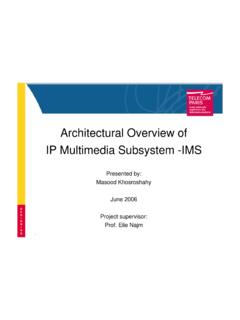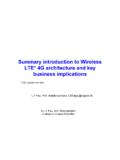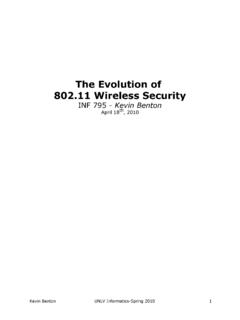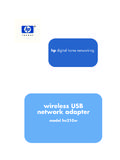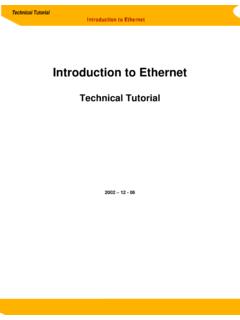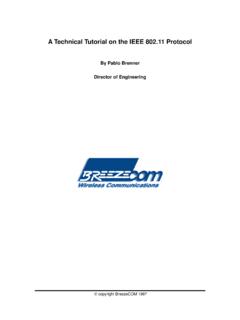Transcription of Study and Implementation of IEEE 802.11 Physical Layer ...
1 Study and Implementation of IEEE Physical Layer Model in YANS (Future NS-3) Network Simulator By Masood Khosroshahy A Thesis Presented to T l com Paris (Ecole Nationale Sup rieure des T l communications). in Fulfillment of the Thesis Requirement for the Degree of Master of Science Networked Computer Systems Supervisors: Philippe Martins [T l com Paris]. Thierry Turletti [INRIA-Sophia Antipolis]. December 2006. Abstract Due to known difficulties of researchers in the networking domain regarding experimentation of their ideas in actual networks, network simulators have become indispensable tools for investigating and validating various ideas in all layers of the network. However, most of the wireless network researchers are not completely familiar with the implications of the assumptions they make for the Physical Layer in their scenarios.
2 For the sake of building the case for a good simulator, it will be demonstrated that unknown assumptions might lead to wrong conclusions about the performance of the protocols under examination. Having a feature-rich IEEE Physical and MAC in a network simulator, which has more chance to be a realistic model, is of paramount interest to both Digital Communications researchers and Networking researchers. This thesis is an effort to Study , design and implement a near-realistic IEEE. Physical Layer model, with all the phenomena associated with this Layer . YANS network simulator, a product of INRIA-Plan te group and father of the future NS-3 network simulator, is the simulator whose Physical Layer is the basis of this thesis work.
3 The Implementation choices have been made based on the original architecture and with the intention of causing as little disturbance as possible to the original mechanics of the simulator. As the principle objective, this thesis examines what it takes to have a feature-rich Physical Layer model, and then as the secondary goal, how these concepts could be implemented in the network simulator. Not all the explored concepts are part of the IEEE standard, like the propagation models;. nonetheless, they play a key role in having a realistic, and working, Implementation . We present the related concepts and Implementation choices, where applicable, in a step-by-step approach within this thesis.
4 Different propagation models, , large-scale path loss models and fading, bit error rate calculation formulas depending on the type of modulation used and the specific channel type under examination, forward error correction mechanism employed in IEEE. and related issues, influence of Viterbi decoder on the bit error rate and, finally, bit error distribution models are the major issues elaborated in this work. As a future work, it is envisaged to validate the results of IEEE simulations with experiments done in ORBIT and/or Emulab testbeds. The intention of this work would be measurement-based validation of our models, by finding a set of Physical Layer configurations, based on which, a strong correlation between simulation and experimentation could be achieved.
5 Ii Acknowledgements I would like to thank Philippe Martins, my thesis supervisor at T l com Paris, for accepting to guide this work. I have come to appreciate his insight on the field during a course in Mobile Networks that I took with him. I am looking forward to see our professional relationship lasts in the foreseeable future. I'd like also to thank Thierry Turletti, my thesis supervisor at INRIA- Plan te group, for his being there for me all along this period. I also acknowledge the help of Mathieu Lacage regarding YANS issues. Thanks to him, I now have a first-hand experience about how important it is to properly document a code as an essential task in any teamwork project.
6 Diego Dujovne, a cheerful guy from Argentina, with whom I have spent a memorable period. Our numerous discussions, regardless of their usefulness, have been very interesting, to say the least. I hereby declare him The Best Colleague that I have ever had. I will also greatly miss our life experience sharing with Katia Obraczka who is currently passing her sabbatical at INRIA, dubbed as "Sabbatical of The Century". Her joy of life and patience have amazed me. I also enjoyed the company of Anwar Al Hamra, Thrasyvoulos Spyropolous (Akis) and Yongho Seok, three Pos-doc researchers at Plan te group. Over time, we have grown friends and I look forward to keeping in touch with them after leaving INRIA.
7 Many thanks go to Walid Dabbous, head of the group, and Chadi Barakat, a permanent researcher in Plan te, for once-in-a-while interesting discussions that we have had. At T l com Paris, I have had the pleasure of working with Elie Najm, Philippe Godlewski, No mie Simoni and G rard Pogorel. I would like to acknowledge the help of these individuals in introducing, and shedding light on, some of the hard-to-understand and interesting topics of the domain. Last, but not least, it's Isabelle Demeure, scientific responsible of Networked Computer Systems Master of Science program at T l com Paris. Her character is an interesting, and rare, mixture of professionalism, seriousness and kindness.
8 Someone who has encouraged me a lot all along the way at T l com Paris. Her advices and recommendations have helped me immensely. I would like to express my deepest gratitude to the individuals named above and wish them all an even more successful career and a cheerful life in the future. Masood Khosroshahy December 2006 [ ]. iii Table of Contents ABSTRACT ---------------------------------------- ---------------------------------------- ---------------------------------------- --- II. ACKNOWLEDGEMENTS------------------------ ---------------------------------------- ---------------------------------------- III. TABLE OF CONTENTS-------------------------------- ---------------------------------------- ----------------------------------- IV.
9 LIST OF TABLES ---------------------------------------- ---------------------------------------- ---------------------------------- VI. LIST OF FIGURES ---------------------------------------- ---------------------------------------- -------------------------------- VII. CHAPTER 1 introduction ---------------------------------------- ---------------------------------------- -------------- 1. introduction ---------------------------------------- ---------------------------------------- ---------------------------------- 1. EXISTING PROBLEM ---------------------------------------- ---------------------------------------- ---------------------------- 2. THESIS OBJECTIVES AND CONTRIBUTIONS ---------------------------------------- ---------------------------------------- --- 2.
10 THESIS ORGANIZATION ---------------------------------------- ---------------------------------------- ------------------------ 2. CHAPTER 2 IEEE PHY-MAC--------------------------------- ---------------------------------------- -------------- 4. introduction ---------------------------------------- ---------------------------------------- ---------------------------------- 4. introduction TO IEEE PHY-MAC ---------------------------------------- ---------------------------------------- 4. introduction ---------------------------------------- ---------------------------------------- ------------------------------- 4. IEEE MAC Layer ---------------------------------------- ---------------------------------------- ---------------- 5.
